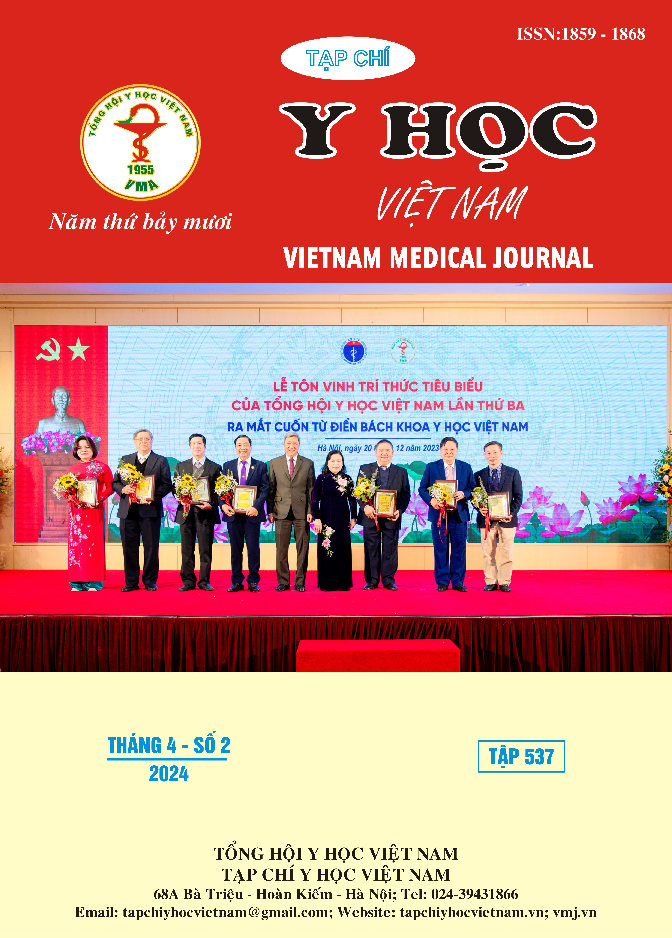RESULT OF SURGERY TREATMENT FOR OCCIPITOCERVICAL INSTABILITY AT SPINAL SURGERY DEPARTMENT OF VIET DUC HOSPITAL FROM 2014 TO 2020
Main Article Content
Abstract
Introduction: Occipitocervical is the joint area between cranial bones with high neck spine C1C2. The occipitocervical junction presents a unique, complex, biomechanical interface between the cranium and the upper cervical spine. This is a region which has large influence on the activity level of the neck spine. Occipitocervical fixation has undergone significant evolution due to advances in operative techniques and instrumentation techniques. We conducted research on this topic to evaluate the effectiveness of fixing occipitocervical with surgery in treatment of occipitocervical instability. Material and methods: Research carried out on patients whose occipitocervical instability is fixed by splints. Results: During the six years (2014-2020), The Spinal Surgery Department of Viet Duc hospital has conducted 17 surgeries on 15 males and 2 females including 15 trauma patients and 2 phatholody ones, average age of whom is 43.41 (from 21 to 67 years old). As regards the clinical presentation, all patients had presented with neck pain before surgery, 8 patients (41.2%) with myelopathy, and 10 patients (66.6%) had presented with a neurological deficit either motor or sensory or both. All patients showed no neurogenous and blood vessels ịnury after surgery, neurological symptoms were improved. Conclusion: This is a reliable and effective method in treatment of occipitocervical instability.
Article Details
References
2. A. Prescher: The craniocervical junction in man, the osseous variations, their significance and differential diagnosis. Ann Anat (1997) 179: 1-19
3. Arnold H.Menezes,MD: Occipitocervical Fixation. World Neurosurgery 73 (2010)6:635-637.
4. Corbett D. Winegar, MD., James P. Lawrence, MD., Brian C. Friel, BA., Carmella Fernandez, MD., Joseph Hong,BS., Mitchell Maltenfort, PhD., Paul A. Anderson, MD., and Alexander R.Vaccaro, MD, PhD: A systematic review of the occipital cervical fusion: techniques and outcomes. J Neurosurg Spine (2010)13:5-16
5. George Sapkas, Stamatios A.Papadakis, Dimitrios Segkos, Kontatinos Kateros, George Tsakotos and Pavlos Katonis: Posterior Instrumentation for Occipitocervical Fusion. The Open Orthopaedics Journal (2011)5: 209-218.
6. Ihab Zidan, Wael Fouad: Occipitocervical fixation in the manegement of craniocervical instabilities. Alexandria Journal of Medicine (2011) 47:185-192.
7. Russ P.Nockels. MD., Christopher I. Shaffrey, MD., Adam S. Kanter, MD., Syed Azeem, MD., and Julie E.York, MD: Occipitaocervical fusion with rigid internal fixation: long-term follow-up data in 69 patients. J Neurosurg Spine (2007)7:117-123.
8. R. Todd Allen, MD, PhD., Robert Decker, MD., Jae Taek Hong, MD., and Rick Sasso, MD: Complications of Occipitocervical Fixation. Spine surgery(2009):167-176.
9. Vincenzo Denaro MD, Alberto Di Martino MD, PhD: Cervical Spine Surgery an Historical Pers pective. Clin Orthop Relat Res (2011) 469:639-648


